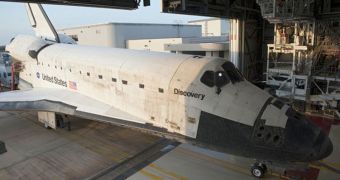For all intents and purposes, the space shuttle Discovery is bound to be delivered to the Smithsonian National Air and Space Museum, in Washington DC. However, before that is done, NASA engineers will have another go at the spacecraft, performing an autopsy of sorts.
The procedure is necessary because the orbiter needs to be cleansed of all the toxic chemicals it contains. Experts must also take out materials that may produce toxic fumes when they deteriorate.
In addition, engineers with the American space agency want to take one last look at the components that make up the shuttle, in a bid to learn more about the effects of space on human space vehicles.
Discovery returned to Earth on March 9, and landed at the Kennedy Space Center, in Florida. NASA is currently drawing up a schedule for it, determining where the spacecraft should go for processing first.
Following the STS-133 mission – its last – the shuttle completed a full 365 days of space time, making it the most used and longest-lived space vehicle in the world. The Space Shuttle Program has been operational for more than 27 years.
After the orbiter landed, it was taken to the Orbiter Processing Facility-2 (OPF-2), where it will undergo the standard processing flow that is applied to each returning shuttle at the end of its mission.
At the end of this process, engineers will not begin to prepare Discovery for its next mission. Rather, they will cut deep into the spacecraft, taking out hazardous components and materials. They will also remove components they want to study, and various pieces that may be of use in other space programs.
The end goal is to make the vehicle safe for public display. “It's not as quick as you might think. It is many, many months away before we'll be ready to hand [Discovery] over,” says Mike Leinbach, who is the shuttle launch director at NASA.
“We are going right into what we are calling our 'transition retirement' processing flow, which in many ways is very similar to the processing flow to get the vehicle ready for flight again,” explains Stephanie Stilson, quoted by Space.
“It is just this time, we are not preparing her for flight, we are preparing her for display,” adds the expert, who is the NASA flow manager for orbiter retirement. She was also the dedicated flow manager for processing Discovery until STS-133 ended.
“We have to get the cryogenic [propellants] out of the fuel cell system, there are some [hypergolic fuels] we need to drain, those types of things. Pyrotechnic cartridges need to be removed. Those types of things are all very standard and that [takes] a couple of weeks,” Leinbach said at a conference.
The NASA associate administrator for space operations, Bill Gerstenmaier, explains that forensics experts will finally get their chance to look at some systems that could not be removed while the shuttle was still in active duty.
“We can still learn a lot from these vehicles. There are some hydraulics systems and some other things that we haven't really had a chance to have a look at because it was really too invasive to get in there and take a look at it,” he explained at the same meeting.
“So we're going to request that the teams help us pull a couple of those components out to do some real detailed forensics on so we can then learn about them for the next generation of vehicles,” he added.
Mike Moses, the NASA launch integration manager, says that there are also additional systems that need to be removed on the orbiter, such as those containing ammonia, nitrogen tetroxide and monomethylhydrazine. All of these compounds are very dangerous.
After this process concludes, the space agency will finally deliver the orbiter to the Smithsonian. Both Endeavor and Atlantis will have to undergo the same process before they are handed over to their respective exhibit centers as well.

 14 DAY TRIAL //
14 DAY TRIAL //